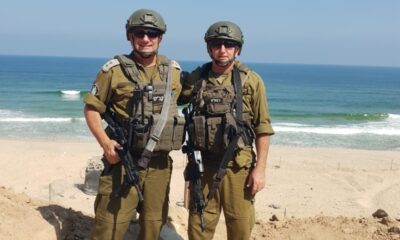
OpEds

Time to emerge from the Iron Dome
One is tempted to quote the old cliché about the fact that those who forget their history are condemned to relive it. The latest troubles in the Middle East are perhaps more nuanced than old clichés reveal, however Israeli intelligence has again been found lacking.
The circumstances are chillingly similar to the ones experienced 50 years ago – almost to the date – when Egyptians and Syrians launched a devastating surprise attack on Yom Kippur in 1973.
Delivering an analysis of the recent cataclysmic events in southern Israel may be a case of “too soon”.
One must remain sensitive to the developing situation. Israel has suffered enormous losses at the time of writing, and Hamas has captured more than a few Israeli soldiers and civilians. The agonising prospect is that Hamas will use these hostages as propaganda toys and bargaining chips in the days, months, and perhaps years to come.
Undoubtedly, the Israel Defense Forces (IDF) will restore the situation militarily, but Israel faces enormous challenges and unenviable choices after that. What next to rid Gaza of Hamas and permanently heal the festering wound on Israel’s southern border?
Military scientists dissect and critically analyse battles in history to extract past mistakes so that students of history will know not to repeat them. The careful study of history also reveals the art of what’s possible under the most challenging circumstances. History has much to offer our warriors in uniform, short of actual combat.
Even while Israel is in a costly battle to regain military control over the regions Hamas has infiltrated, many are incredulous at how Israel finds itself in a precarious position driven by what seems to be a complete intelligence failure. It’s too soon to offer hard facts on a subject that will be extensively examined inside and outside the country for many years. However, some of the reasons for the lapse in Israeli concentration are obvious, while others, though less obvious, are no less discernible.
At first glance, Hamas may have committed a severe blunder at strategic level. Its murderous and ruthless surprise attack has cost it the sympathy vote, at least in the West. Israel has miraculously, perhaps temporarily, regained the moral high ground.
The sudden invasion has galvanised the fractured Israeli society, which was threatening to tear the country apart a few short days ago. Talks of a possible civil war, maybe far-fetched, have been averted. Hamas has shot its bolt and inadvertently handed Israel a golden opportunity to rid itself of the terrorist scourge in Gaza comprehensively and with the full backing of the West
Therefore, a severe setback at the operational and tactical level of warfare has created a strategic opportunity for Israel. Or as they say in Afrikaans “geluk by die ongeluk”. In brief, this is where Israel finds itself, and it will take a mighty commitment to ensure that the chance to obliterate Hamas isn’t squandered.
How did Israel get here? Although the outcome of the insurgency is almost certainly an Israeli military victory, the IDF’s image will suffer in the eyes of Israelis because it failed to protect the southern border. The country has never been more divided against itself. Fractured societies are vulnerable.
While Israel has been devoted to pressing internal matters and Israelis fight among themselves, their enemies have taken advantage of the opportunities presented. Security issues have taken a back seat to political expediency. Complacency is another powerful enemy. “Safe” behind their high walls and Iron Dome, with the occasional retaliatory surgical air strike, Israelis have become comfortable with the status quo brought about by overwhelming military superiority.
All seemed relatively under control, with Hamas hermetically sealed in Gaza and Arab countries lining up to restore diplomatic relations. A potent mixture of hubris, distraction, and being lulled by the status quo created a perfect storm for Hamas to exploit.
Here’s a lesson from history. Building static defensive positions hands over the initiative to the enemy. The infamous French Maginot Line in World War II exemplified the French defensive mentality brought about by the false sense of security offered by fortifications. The Germans, seizing the initiative, quickly overcame the French defences by simply bypassing them. Similarly, the Bar-Lev line straddling the East Bank of the Suez Canal inculcated an Israeli defensive mentality. This stood in stark relief to its penchant for manoeuvre in the remarkable Six-Day War. Israel handed the initiative to the Arab armies in 1973, and suffered the enduring consequences of fighting on the back foot for most of the war at a significant cost.
The Iron Dome and extensive border wall are defensive measures that allow Hamas to determine the time and place of an attack. Hamas holds the initiative. Extensive tunnel systems allow Hamas to concentrate its forces in time and space and achieve overwhelming firepower at a point of its choosing. Israel mans static positions along the border, and conducts itself in a reactionary manner.
Like most Western powers, Israel has placed its trust in superior technology. It sees technology as an answer to avoiding casualties rather than placing boots on the ground. An example of such technology is the Iron Dome. Each Iron Dome battery costs $150 million (R2.9 billion), and an interceptor missile costs $50 000 (R958 400). The Iron Dome is pitted against Hamas’ unguided, short-range rockets, which cost between $300 and $800 (R5 750 and R15 300) to make and have an estimated range of about 10km. The maths overwhelmingly favours Hamas, who has lately used swarming tactics to partly overwhelm the Iron Dome in the opening phases of the insurgency.
Israeli airstrikes have proved ineffective against Hamas rocket sites, and all the technology, just like in Afghanistan and Iraq, has proved to have little deterrent effect on a determined enemy. World War II, Vietnam, and the current Ukraine war adequately demonstrate that bombing urban areas strengthens civilian resolve rather than the opposite.
Occupying Gaza for a decent length of time with boots on the ground seems to be an idea growing in likelihood by the hour. However, asymmetrical warfare in a densely populated urban area is a nasty prospect.
Israel may have to consider occupying Gaza, and using combined armed forces of aircraft, tanks, artillery, and infantry working in unison to hunt down and neutralise Hamas as a fighting force. The extensive Gaza tunnel system must also be destroyed to deny Hamas its logistics and means of cover and concealment.
Israel must seize the initiative, climb from under its defensive systems, and occupy Gaza. This will come at an enormous human and political cost, but a comprehensive military solution may create the space for a political one thereafter.
- Dr David Brock Katz is a research fellow at Stellenbosch University in the faculty of military science. He has published three books and numerous academic articles dealing with aspects of South African military history and military doctrine.










